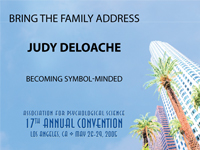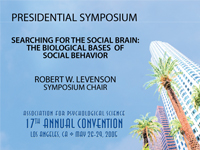Liar, Liar, Brains on Fire
Richard Milhouse Nixon, perhaps the most recognizable public deceiver of the 20th century, once said, “I don’t know anything about lie detectors, other than that they scare the hell out of people.” As one of the nation’s leading researchers on the topic, John J. B. Allen, University of Arizona, knows quite a bit about lie detectors — enough to know that Nixon’s words, in this case, could not ring more true.
Like Nixon, most people know very little about the standard polygraph. For one thing, said Allen in his invited talk, “Is Brainfingerprinting Ready for Prime Time?” it doesn’t even detect lies. “[The polygraph] does not detect lying, per se, it merely detects physiological changes that might be associated with lying,” he said. “Anyone who claims to measure lying is lying.”
The first such claim appeared in 1915, when William Moulton Marston invented a machine that could detect lies by looking at changes in blood pressure. Despite its imposing apparatus — the elaborate patchwork of cords, the needle etching guilt or innocence onto a paper just outside a subject’s periphery — the polygraph is founded on a simple assumption: A guilty person, when presented with questions relevant to his or her guilt, will unwittingly display a stronger physical response than he or she would to general control questions.
But while the polygraph’s control question technique detects guilty people almost 90 percent of the time, only 57 percent of innocent people are correctly classified. To Allen, this means that 43 percent of innocent people are inaccurately determined to be guilty. As a result, he prefers another method of questioning known as the Guilty Knowledge Technique, or GKT, which depends not on emotional arousal but on specific facts that only a criminal or somebody involved with the crime would know. Using the GKT, Allen correctly classifies 79 percent of guilty subjects — a high figure, though lower than the polygraph’s. More importantly to Allen, the GKT is “superior to the control testing technique in protecting the innocent,” correctly classifying innocent people 94 percent of the time.
Still, the polygraph community has resisted the GKT, primarily because it relies on hard-to-find details about a crime. Instead, Allen advocates a slight modification of the GKT, something he refers to, though did not coin, as “brainfingerprinting.”
Brainfingerprinting measures brain activity to find information that people might recognize, whether or not they are willing to report it. Unlike the GKT, which bases its success on a subject’s overt response, brainfingerprinting maps all neural responses in a series of dips and leaps. The most memorable items — those that are “distinct, rare, and significant” — trigger the most extreme amplitudes, Allen said, particularly when they are embedded in a long line of unmemorable items.
“Brainfingerprinting can determine scientifically whether a suspect has details of a crime stored in his brain,” he said. “These procedures shouldn’t depend upon a person overtly acknowledging that they’ve learned something.”
To test brainfingerprinting, Allen had subjects learn two lists of words and conceal from him the fact that they had learned the first list. Subjects were then presented with seven words: one they admitted learning, one they had learned but denied learning, and five they had not encountered on either list. Since the learned words (whether admitted or denied) represented a “distinct, rare, and significant” proportion of those presented, brainfingerprinting should be able to declare them as salient.
Across 60 subjects, Allen received similar results for those who said I’ve learned it and those who said I haven’t learned it but in fact really had. These results were replicated with little variation despite different incentives to lie, including money. Using brainfingerprinting, Allen could classify learned words as learned 94 percent of the time; 96 percent of the time he could classify unlearned words as unlearned.
“Independent of the subject’s overt response,” he said, “the brainwaves can detect when somebody recognizes something.”
Despite the impressive results, brainfingerprinting is not without flaws. Using the Deese-Roediger-McDermott method, Allen and collaborators induced false memories into subjects prior to testing with brainfingerprinting. As before, subjects were presented with a list of words: bed, rest, tired, pillow, snooze. When a brainfingerprinting scenario was presented on the basis of this list, brains still gave a high reaction to the word “sleep,” judging it to be distinct, rare, and significant even though it was not on the original list.
“There may be cases where memory is inaccurate, and if memory is inaccurate, the procedure may be inaccurate,” Allen said. Thus, an innocent person repeatedly interrogated may become so well acquainted with intimate features of the crime that his or her brainwaves would no longer classify them as unmemorable, and might give the false impression of guilt.
On the basis of these results, Allen declared a few things for certain: For their ability to “scare the hell out of people,” polygraphs are useful in eliciting confessions and therefore remain a valuable tool. Procedures that focus on recognition rather than emotional reactions are more accurate than polygraphs and seldom identify an innocent person as guilty. But given potential memory flaws, are they ready to replace the polygraph in prime time? “No,” said Allen, putting himself on the stand, “and that’s the truth.”




APS regularly opens certain online articles for discussion on our website. Effective February 2021, you must be a logged-in APS member to post comments. By posting a comment, you agree to our Community Guidelines and the display of your profile information, including your name and affiliation. Any opinions, findings, conclusions, or recommendations present in article comments are those of the writers and do not necessarily reflect the views of APS or the article’s author. For more information, please see our Community Guidelines.
Please login with your APS account to comment.